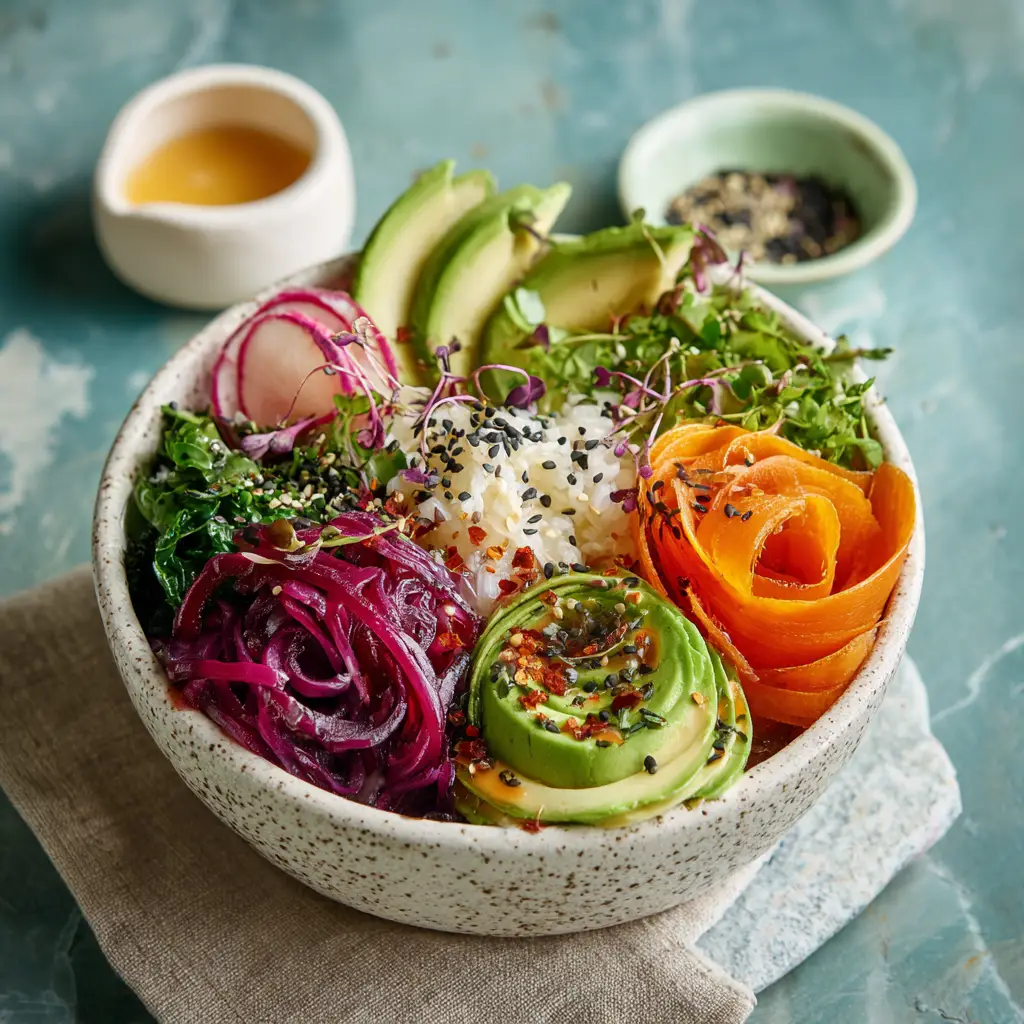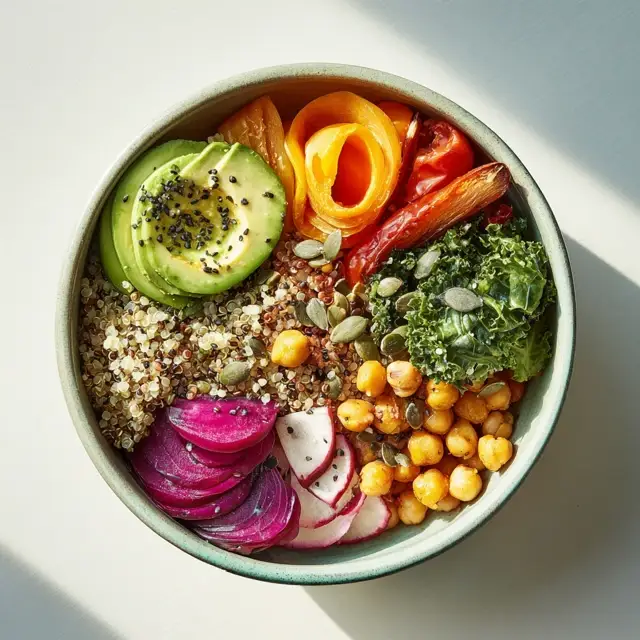Healthy Bowls Recipes: Delicious, Nutritious, and Easy to Make
Introduction
Healthy bowls have become one of the most popular ways to enjoy a balanced meal. Combining fresh vegetables, wholesome grains, lean proteins, and flavorful dressings, these bowls offer both convenience and nutrition. Eating well does not have to be complicated. By preparing a bowl packed with vitamins, minerals, and fiber, it is possible to nourish the body while keeping meals exciting and visually appealing. Bowls can be prepared ahead of time for busy mornings or evenings, making them a perfect solution for anyone looking to maintain a healthy lifestyle without sacrificing taste.

The versatility of healthy bowls allows endless creativity. Seasonal produce can be incorporated, offering natural flavors that change throughout the year. Adding different proteins or grains can transform a single recipe into multiple options, so meals never feel repetitive. The colors, textures, and aromas in a well-prepared bowl make eating an enjoyable experience while supporting long-term health goals. Each bite becomes a balance of essential nutrients, satisfying both hunger and cravings.
Beyond nutrition, healthy bowls also help promote mindful eating. By visually organizing each component, it becomes easier to recognize portion sizes and maintain dietary balance. Bowls appeal to those who want control over ingredients and flavor combinations. A thoughtfully composed bowl is not only a feast for the body but also a feast for the eyes.
Ingredients Needed
Creating a healthy bowl begins with choosing fresh and nutrient-dense ingredients. Below is a table listing a popular combination along with approximate calorie counts per serving. Adjust quantities according to personal preferences or dietary needs.
| Ingredient | Quantity | Calories |
|---|---|---|
| Quinoa | 1 cup cooked | 222 |
| Spinach | 1 cup | 7 |
| Cherry Tomatoes | 1 cup | 27 |
| Cucumber | 1 cup sliced | 16 |
| Carrots | 1 medium | 25 |
| Chickpeas | 1 cup cooked | 269 |
| Avocado | 1/2 medium | 120 |
| Olive Oil | 1 tablespoon | 119 |
| Lemon Juice | 1 tablespoon | 4 |
| Tahini | 1 tablespoon | 89 |
| Salt | 1/4 teaspoon | 0 |
| Black Pepper | 1/4 teaspoon | 1 |
These ingredients provide a balance of macronutrients. Quinoa supplies protein and complex carbohydrates, while chickpeas add additional protein and fiber. Fresh vegetables contribute vitamins and minerals, and avocado delivers healthy fats. Olive oil and tahini enhance flavor and contribute heart-healthy fats.

Step-by-Step Cooking Instructions
- Begin by cooking the quinoa. Rinse one cup under cold water to remove excess starch. Add it to two cups of water in a medium saucepan. Bring to a boil, then reduce heat and simmer for fifteen minutes. Remove from heat and allow to sit covered for five minutes. Fluff with a fork before adding to your bowl.
- While the quinoa is cooking, prepare the vegetables. Slice the cucumber into thin rounds. Halve the cherry tomatoes. Peel and grate the carrot. Wash and dry the spinach thoroughly.
- If using canned chickpeas, drain and rinse them under cold water. Optionally, roast them with a little olive oil and paprika for added texture and flavor.
- In a small bowl, mix olive oil, lemon juice, tahini, salt, and black pepper to create a simple dressing. Whisk until smooth. Adjust seasoning to taste.
- Assemble the bowl by layering the quinoa as the base. Arrange spinach, cucumbers, cherry tomatoes, carrots, and chickpeas on top. Slice avocado and place it in one section of the bowl. Drizzle the dressing evenly over all ingredients.
- Toss lightly if desired or leave components separated for a visually appealing presentation. The bowl is ready to serve immediately.
Tips for Customizing the Recipe
Healthy bowls can be tailored to individual taste preferences or dietary needs. Experimenting with different grains like brown rice, farro, or bulgur can add variety and texture. Swap chickpeas for grilled chicken, tofu, or salmon for additional protein options. Seasonal vegetables can be rotated for freshness and color.
Dressings can also be modified. A simple yogurt-based dressing, balsamic glaze, or miso vinaigrette can completely change the flavor profile. Adding seeds or nuts such as pumpkin seeds, sunflower seeds, or almonds introduces crunch and enhances nutrient density. Fresh herbs like cilantro, parsley, or basil add bright flavor without extra calories.
Spices are another easy way to customize bowls. Cumin, smoked paprika, or turmeric provide warmth and complexity. For those who prefer heat, adding chili flakes or a drizzle of sriracha creates a subtle kick. Portion sizes can be adjusted to meet caloric needs, making these bowls suitable for weight management or athletic performance.

Nutritional Information
The healthy bowl recipe above provides a balanced mix of macronutrients and micronutrients. Each serving delivers approximately:
- Calories: 898 kcal
- Protein: 28 grams
- Carbohydrates: 101 grams
- Fiber: 21 grams
- Fat: 33 grams
- Vitamins: A, C, K, and folate
- Minerals: Iron, magnesium, and potassium
The high fiber content supports digestive health, while protein keeps you full for longer periods. Healthy fats from avocado, olive oil, and tahini promote heart health and improve absorption of fat-soluble vitamins. The combination of fresh vegetables ensures that every bite provides antioxidants and phytonutrients that support immunity and overall well-being.
Serving Suggestions
Healthy bowls are versatile for meals at any time of day. Serve them as a main course for lunch or dinner, paired with a side of fresh fruit or a light soup. For meal prep, store ingredients separately in airtight containers to maintain freshness and prevent sogginess.
Bowls can also be served warm or cold depending on preference. A warm bowl is comforting in cooler months, while a chilled version is refreshing during summer. Garnish with fresh herbs, seeds, or a squeeze of lemon to enhance visual appeal and flavor. Sharing these bowls with friends or family makes for a delightful and nutritious dining experience.
Healthy Bowls Recipes: Delicious, Nutritious, and Easy to Make
2-3
servings15
minutes20
minutes450
kcalIngredients
1 cup cooked quinoa
1 cup fresh spinach
1 cup cherry tomatoes, halved
1 cup cucumber, sliced
1 medium carrot, grated
1 cup cooked chickpeas (or roasted)
1/2 medium avocado, sliced
1 tablespoon olive oil
1 tablespoon lemon juice
1 tablespoon tahini
1/4 teaspoon salt
1/4 teaspoon black pepper
Directions
- Cook the quinoa: Rinse quinoa under cold water. In a medium saucepan, add 1 cup quinoa and 2 cups water. Bring to a boil, reduce heat, and simmer for 15 minutes. Remove from heat and let it sit covered for 5 minutes. Fluff with a fork.
- Prepare vegetables: Slice cucumber, halve cherry tomatoes, grate the carrot, and wash spinach.
- Prepare chickpeas: Drain and rinse canned chickpeas. Optionally, roast with a teaspoon of olive oil and a pinch of paprika for 10 minutes for extra flavor.
- Make the dressing: In a small bowl, whisk together olive oil, lemon juice, tahini, salt, and black pepper until smooth. Adjust seasoning as needed.
- Assemble the bowl: Layer cooked quinoa as the base. Arrange spinach, cucumber, cherry tomatoes, carrot, chickpeas, and avocado on top. Drizzle dressing over all ingredients.
- Serve: Toss lightly if desired, or leave layered for presentation. Serve immediately.
Notes
- For added crunch, sprinkle pumpkin seeds, sunflower seeds, or chopped nuts on top.
Swap quinoa with brown rice, farro, or couscous for variety.
Make it vegan by using plant-based protein like tofu or tempeh instead of chickpeas if preferred.
Dressing can be stored in the fridge for up to 3 days.
FAQs
Can I make healthy bowls ahead of time?
Yes, components can be prepared in advance. Store grains, proteins, and vegetables separately and assemble just before eating to maintain texture and flavor.
Are healthy bowls suitable for vegetarians and vegans?
Absolutely. By focusing on plant-based proteins such as beans, lentils, tofu, and tempeh, healthy bowls provide all essential nutrients.
How can I reduce calories in a healthy bowl?
Use smaller portions of high-calorie ingredients like avocado, olive oil, and tahini. Increase vegetables and leafy greens to maintain volume and satiety.
Can I add grains other than quinoa?
Yes. Brown rice, farro, barley, or couscous are excellent alternatives that offer unique flavors and textures.
Is it possible to make a gluten-free healthy bowl?
Definitely. Most grains like quinoa and rice are naturally gluten-free. Ensure that sauces and dressings do not contain hidden gluten.
Conclusion
Healthy bowls offer a convenient and nutritious way to enjoy meals packed with flavor and color. By combining fresh vegetables, protein, grains, and wholesome fats, it is possible to create a balanced dish that nourishes the body and delights the senses. Customization allows endless variations to suit different tastes, dietary needs, and seasonal produce. Preparing bowls encourages mindful eating, portion control, and a sustainable approach to healthy living. The simplicity and versatility make these bowls an ideal choice for anyone seeking delicious, nutrient-rich meals that are easy to make at home.







